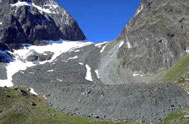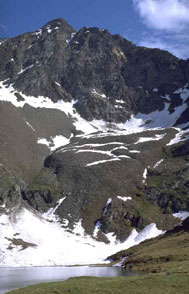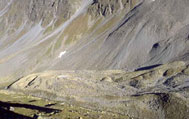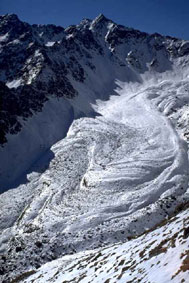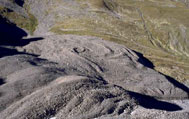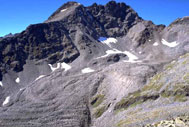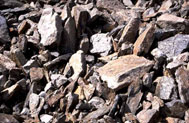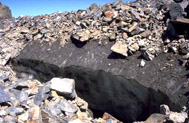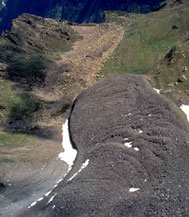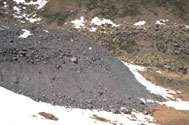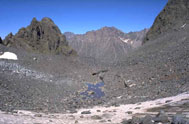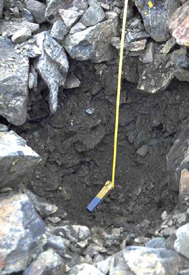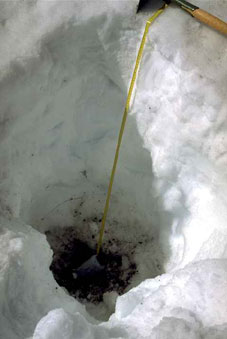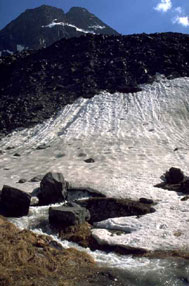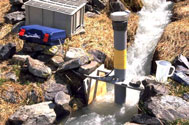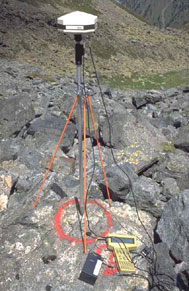Institute for Geology and Paleontology
University of Innsbruck
|
About rock glacier |
Rock Glaciers - An introduction with examples from the Austrian Alps
This brief introduction is based mainly on observations and investigations on rock glaciers in the Ötztal Alps and Stubai Alps, Tyrol, and the Schobergruppe, Hohe Tauern National Park, Carinthia. The most characteristic features are documented by a number of photographs and by some diagrams.
Rock glaciers are lobate to
tongue-shaped bodies of frozen debris with interstitial ice
cement, ice lenses, or a core of massive ice. Rock glaciers
belong to the most spectacular and most widespread
periglacial phenomenon on earth.
Active rock glaciers are moving downslope or downvalley by
internal deformation of ice, probably also by basal
gliding.
Hypothesis about the origin of rock glaciers is still
controversial. One group of scientists states that they are
strictly the result of periglacial processes, the other
group argues that rock glaciers may also evolve from
debris-covered glaciers.
Rock glaciers of permafrost origin are sometimes classified
as "ice-cemented rock glaciers", and those of glacial origin
as "ice-cored rock glaciers".
In Austria rock glaciers are widespread, particularly in the
mountain groups of the Central Alps (e.g. Silvretta,
Ötztal Alps, Stubai Alps, Deferegger Alps,
Schobergruppe) above 2300 - 2500 m.
Based on ice-content and activity the following types of
rock glaciers are distinguished:
|
Active rock glaciers contain substantial amounts of ice and are moving downslope or downvalley with velocities typically ranging from several centimeters/year to several meters/year. |
|
|
Inactive rock glaciers still contain some ice, but are not moving. |
|
|
Fossil rock glaciers do not contain ice, all the ice is molten out, the surface, particularly the front slope, is frequently covered by vegetation, the gradient of the front slope is less steep than that of active rock glaciers. |
The shape of rock glaciers may be
- tongue-shaped (length : width ration > 1)
- lobate (length : width ration < 1) or
- complex
In the Austrian Alps most rock glaciers are up to a few hundred meters long, 50 - 200 meters wide and cover an area of up to 0.2 km². Reichenkar rock glacier in the western Stubai Alps, 1400 m long, is one of the largest rock glaciers.
The surface is characterized by a coarse grained debris layer ("active layer"),
which is underlain by frozen debris and/or ice.
The surface of most active rock glaciers is characterized by well developed longitudinal and transversal ridges and furrows.
The front slope of active rock glaciers is characterized by a steep gradient (40 - 45°), is bare of vegetation and composed of fresh, unweathered material.
In the root zone of some rock glaciers a spoon-shaped depression is developed, which formed by the melting of massive ice under the debris layer.
Temperatures in the debris layer
The heat budget of the debris layer is very complex and depends on several parameters, particularly by the weather conditions, the grain-size distribution and thickness of the debris layer, and the ground ice below.
In summer a rapid decrease in air temperature is observed from the surface to a depth of 150 cm. During clear and warm weather in summer daily temperature cycles are recorded to a depth of 100 - 150 cm, with a time lag of several hours (the minimum temperature occurs between 10 - 12 a.m., and maximum temperature occurs between 6 and 12 p.m).
Temperatures at the base of the winter snow cover (BTS)
As a thick snow cover acts as an isolating layer, air temperature at the base of the winter snow cover is mainly influenced by the heat flow of the underlying ground ice. Therefore, air temperatures at the base of the winter snow cover (BTS) do not show any daily temperature variations, and on active rock glaciers are generally below -3°C, whereas on permafrost-free ground BTS is significantly higher, mostly ranging between -0.3°C and -1°C.
Temperatures of the meltwater released from active rock glaciers are very low and astonishingly constant during the whole melt season, ranging between 0.4 and 0.9°C. This low water temperature indicates that the meltwater released at the rock glacier spring was in direct contact with ice when flowing through the rock glacier.
Discharge of active rock glaciers is characterized by strong seasonal and diurnal variations.
Water released from active rock glaciers is derived from snowmelt, melting of permafrost and/or glacier ice, atmospheric precipitation during summer thunderstorms and groundwater.
Meltwater flows through the rock glaciers on the surface of the permafrost ice (at the permafrost table), particularly along furrows on the upper portion of the rock glacier as channel flow and subordinately as sheet flow, englacial (in the permafrost layer) along moulins, and along subglacial channels at the base of the permafrost layer, particularly in the middle and lower portion of the rock glaciers.
Discharge is controlled by a number of parameters: the thickness of the winter snow cover, the size of rock glacier and drainage area, the presence of cirque glacier(s) in the drainage area, the thickness and grain size of the debris mantle/active layer, the groundwater supply and the weather conditions during the melt period, particularly summer thunderstorms, causing pronounced seasonal and diurnal variations.
Water derived from snowmelt and rainfall events is immediately released causing floods which represent the quickflow component of the hydrograph.
Fair weather periods with intense melting of snow and ice in the early afternoon are characterized by diurnal variations in discharge.
Electrical conductivity of the water is low during high discharges due to high amounts of meltwater derived from snow/icemelt and/or precipitation, and high during cold weather periods and in autumn when discharge is very low and consists mainly of groundwater.
Most rock glaciers are characterized by average surface velocities of a few tens of centimeters per year. In Austria highest velocities are recorded from Hochebenkar rock glacier (up to 5 m/year) and Reichenkar rock glacier (up to 2.5 m/year in the snout zone and up to 6.94 m/year on a highly active part in the steep intermediate zone in the period 1998 - 1999).
For further informations please contact Karl Krainer or Wolfram Mostler
Ackert, R. P. (1998). "A rock glacier/debris-covered glacier system at Galena Creek,
Absaroka Mountains, Wyoming." Geografiska Annaler 80(3-4): 267-276.
Barsch, D. (1996). Rockglaciers. Indicators for the Present and Former Geoecology in High Mountain Environments. Berlin, Springer-Verlag.
Clark, D. H., M. M. Clark, et al. (1994). "Debris-Covered Glaciers in the Sierra Nevada, California, and Their Implications for Snowline Reconstructions." Quaternary Research 41: 139-153.
Clark, D. H., E. J. Steig, et al. (1996). "Old ice in rock glaciers may provide long-term climate records." Eos, Transactions, American Geophysical Union 77: 217,221-222.
Clark, D. H., E. J. Steig, et al. (1998). "Genetic variability of rock glaciers." Geografiska Annaler 80 A(3-4): 175-182.
Giardino, J. R., J. F. Shroder, et al. (1987). Rock Glaciers. London, Allen & Unwin.
Haeberli, W. (1973). "Die Basis-Temperatur der winterlichen Schneedecke als möglicher Indikator für die Verbreitung von Permafrost in den Alpen." Zeitschrift für Gletscherkunde und Glazialgeologie 9: 221-227.
Haeberli, W. (1985). "Creep of mountain permafrost: Internal structure and flow of alpine rock glaciers." Mitteilungen der Versuchsanstalt für Wasserbau, Hydrologie und Glaziologie ETH Zürich 77: 1-142.
Haeberli, W. (1992). "Construction, Environmental Problems and Natural Hazards in Periglacial Mountain Belts." Permafrost and Periglacial Processes 3: 111-124.
Humlum, O. (1996). "Origin of Rock Glaciers: Observations from Mellemfjord, Disko Island, Central West Greenland." Permafrost and Periglacial Processes 7: 361-380.
Johnson, P. G. (1978). "Rock glacier types and their drainage systems, Grizzly Creek, Yukon Territory." Canadian Journal of Earth Sciences 15: 1496-1507.
Johnson, P. G. (1987). Rock glacier: glacier debris systems or high-magnitude low-frequency flows. Rock Glaciers. J. R. Giardino, J. F. Shroder and J. D. Vitek. London, Allen & Unwin: 175-192.
Konrad, S. K., N. F. Humphrey, et al. (1999). "Rock glacier dynamics and paleoclimatic implications." Geology 27(9): 1131-1134.
Martin, H. E. and W. B. Whalley (1987). "Rock glaciers, part 1: rock glacier morphology: classification and distribution." Progress in Physical Geography 11: 260-282.
Potter, N. (1972). "Ice-Cored Rock Glacier, Galena Creek, Northern Absaroka Mountains, Wyoming." Geological Society of America Bulletin 83: 3025-3058.
Potter, N., E. J. Steig, et al. (1998). "Galena Creek rock glacier revisited - new observations on an old controversy." Geografiska Annaler 80(3-4): 251-265.
Shroder, J. F., M. P. Bishop, et al. (2000). "Debris-covered glaciers and rock glaciers in the Nanga Parbat Himalaya, Pakistan." Geografiska Annaler 82A(1): 17-31.
VonderMühll, D. and P. Holub (1992). "Borehole Logging in Alpine Permafrost, Upper Engadin, Swiss Alps." Permafrost and Periglacial Processes 3: 125-132.
VonderMühll, D., T. Stucki, et al. (1998). Borehole temperatures in Alpine permafrost: a ten years series. 7th International Conference on Permafrost, Yellowknife.
Wahrhaftig, C. and A. Cox (1959). "Rock glaciers in the Alaska Range." Geological Society of America Bulletin 70: 383-436.
Whalley, W. B. and H. E. Martin (1992). "Rock glaciers:II models and mechanisms." Progress in Physical Geography 16(2): 127-186.
Whalley, W. B. and C. F. Palmer (1998). "A glacial interpretation for the origin and formation of the Marinet Rock Glacier, Alpes Maritimes, France." Geografiska Annaler 80(3-4): 221-236.
Rock glacier
working group
Institute
for Geology and
Paleontology
University
of Innsbruck

